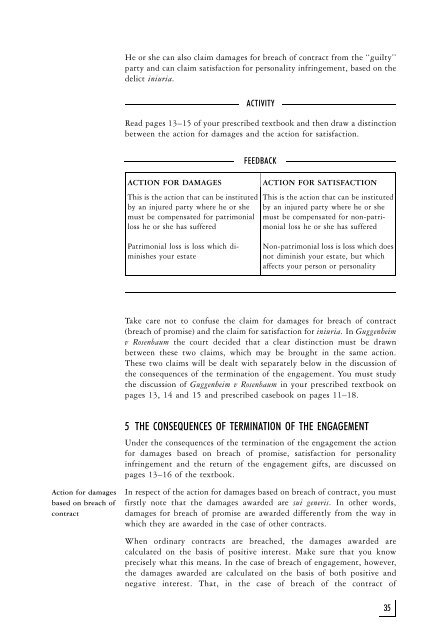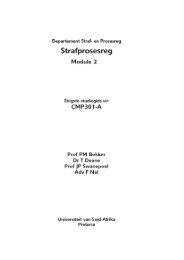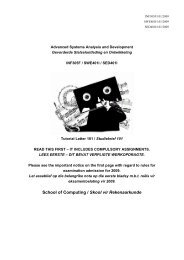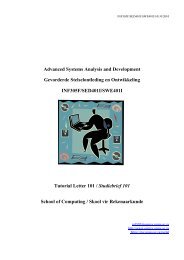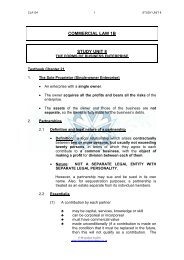key to the study guide - Name
key to the study guide - Name
key to the study guide - Name
You also want an ePaper? Increase the reach of your titles
YUMPU automatically turns print PDFs into web optimized ePapers that Google loves.
Action for damages<br />
basedonbreachof<br />
contract<br />
He or she can also claim damages for breach of contract from <strong>the</strong> ``guilty''<br />
party and can claim satisfaction for personality infringement, based on <strong>the</strong><br />
delict iniuria.<br />
ACTIVITY<br />
Read pages 13±15 of your prescribed textbook and <strong>the</strong>n draw a distinction<br />
between <strong>the</strong> action for damages and <strong>the</strong> action for satisfaction.<br />
FEEDBACK<br />
ACTION FOR DAMAGES ACTION FOR SATISFACTION<br />
This is <strong>the</strong> action that can be instituted<br />
by an injured party where he or she<br />
must be compensated for patrimonial<br />
loss he or she has suffered<br />
Patrimonial loss is loss which diminishes<br />
your estate<br />
This is <strong>the</strong> action that can be instituted<br />
by an injured party where he or she<br />
must be compensated for non-patrimonial<br />
loss he or she has suffered<br />
Non-patrimonial loss is loss which does<br />
not diminish your estate, but which<br />
affects your person or personality<br />
Take care not <strong>to</strong> confuse <strong>the</strong> claim for damages for breach of contract<br />
(breach of promise) and <strong>the</strong> claim for satisfaction for iniuria. In Guggenheim<br />
v Rosenbaum <strong>the</strong> court decided that a clear distinction must be drawn<br />
between <strong>the</strong>se two claims, which may be brought in <strong>the</strong> same action.<br />
These two claims will be dealt with separately below in <strong>the</strong> discussion of<br />
<strong>the</strong> consequences of <strong>the</strong> termination of <strong>the</strong> engagement. You must <strong>study</strong><br />
<strong>the</strong> discussion of Guggenheim v Rosenbaum in your prescribed textbook on<br />
pages 13, 14 and 15 and prescribed casebook on pages 11±18.<br />
5 THE CONSEQUENCES OF TERMINATION OF THE ENGAGEMENT<br />
Under <strong>the</strong> consequences of <strong>the</strong> termination of <strong>the</strong> engagement <strong>the</strong> action<br />
for damages based on breach of promise, satisfaction for personality<br />
infringement and <strong>the</strong> return of <strong>the</strong> engagement gifts, are discussed on<br />
pages 13±16 of <strong>the</strong> textbook.<br />
In respect of <strong>the</strong> action for damages based on breach of contract, you must<br />
firstly note that <strong>the</strong> damages awarded are sui generis. In o<strong>the</strong>r words,<br />
damages for breach of promise are awarded differently from <strong>the</strong> way in<br />
which <strong>the</strong>y are awarded in <strong>the</strong> case of o<strong>the</strong>r contracts.<br />
When ordinary contracts are breached, <strong>the</strong> damages awarded are<br />
calculated on <strong>the</strong> basis of positive interest. Make sure that you know<br />
precisely what this means. In <strong>the</strong> case of breach of engagement, however,<br />
<strong>the</strong> damages awarded are calculated on <strong>the</strong> basis of both positive and<br />
negative interest. That, in <strong>the</strong> case of breach of <strong>the</strong> contract of<br />
35


